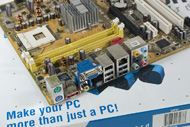Asus N4L-VM DH Core Duo Motherboard
Layout And Setup - Continued
The 945GT's integrated GMA950 integrated graphics core is the first to be fully Windows Vista compliant, meaning that it supports DirectX 9.0C class pixel/vertex shading abilities. The GMA950 core is powerful enough for standard desktop PC's and for Home Theater boxes, but certainly won't be powerful enough for any real gaming. However, we should note that the GMA950 core isn't as terrible as one would expect in a gaming environment. Older games like Unreal Tournament 2004 will run fine at lower resolutions, although trying new games like FEAR or Oblivion on this GPU would be a frustrating experience. Performance wise, it will be similar to nVidia's GeForce 6200 or ATI's Radeon X300 series. The real issue, however, is outputs. Asus decided to only provide an analog HD-15 output connector from the GMA950 onboard audio, forgoing a higher-quality DVI port instead. With the vast amount of new HD screens and TVs on the market being sold supporting DVI connectivity, the lack of such a connector is quite a shame.

|

|
If you have the need for a more high-powered graphics solution, Asus does provide a full PCI Express x16 graphics card slot, in addition to a PCI Express x1 slot and two 32-bit PCI slots. The board also supports 2 x Serial ATA-II/300 ports connected via the Intel ICH7M (Mobile) RAID Southbridge. These ports support RAID-0 and RAID-1, in addition to the (highly under-appreciated) Intel Matrix RAID technology. There is also a second Serial ATA Controller onboard by a company called JMicron, which controls a third onboard Serial ATA-II/300 port along with an external SATA port on the I/O backplane. This port supports eSATA / SATA-On-The-Go, for connecting external SATA devices for additional high-speed storage. The N4L-VM DH does currently have a bug where CPU performance is higher than usual when ACHI mode is enabled - this can be fixed by changing the onboard Serial ATA to "IDE" mode. (Thanks to our friends at Tech Report for discovering this issue).

|

|
The motherboard supports Intel HD Audio through a Realtek ALC882M CODEC and the board allows 8-channel analog output and 7.1 digital output through its coaxial or optical S/PDIF ports. As noted by the sticker on the top of the box, this board supports Dolby Digital Live and Dolby Master Studio, which allows for real-time encoding of audio content for output to a 7.1 digital speaker setup. The board has onboard Gigabit Ethernet which is connected through the native ICH7M Southbridge.

|

|
The N4L-VM DH is the first motherboard we've tested which has Intel's ViiV logo splashed all over it. Intel has sunk a lot of marketing dollars into the ViiV campaign, but has done a pretty terrible job of actually detailing what the platform includes. Unlike Centrino, another Intel "Platform", ViiV doesn't follow a particularly strict set of guidelines. Centrino was three core components - if it didn't use all three of those components, it wasn't a Centrino platform, and this simplicity worked. ViiV is much broader, as ViiV platforms could literally encompass thousands of different configurations.
The key features which a ViiV PC must have are a dual-core processor, a 975x/955x/945-series chipset, at least 7.1 audio abilities, a SATA-II/300 hard drive, dual channel DDR2-667 memory (or greater), and the ability to support instant on/off. The Asus board supports instant on/off, and even installs a hardware driver for this ability. Instant on/off allows the system to go into a deep sleep mode, where the system is virtually turned off (fans don't turn, power consumption is dramatically cut). However, when the power button (or a remote control power button) is pressed, the system can wake from the sleep mode in 2-3 seconds. This function is great for Home Theater PC's, as instant on/off allows the PC to function more like a television compared to a PC which has been unwillingly thrown into a living room.






